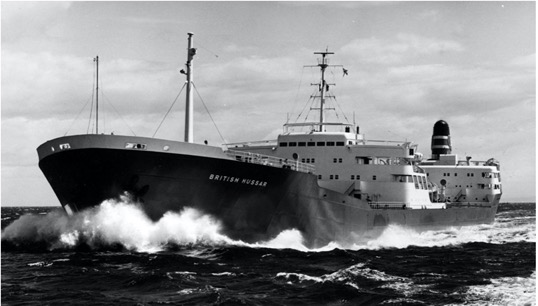British Hussar

The build
The 52,546dwt British Hussar was built on the Clyde at the John Brown shipyard and was the second vessel to bear the name, with the 1923-built British Hussar having been broken up in Rosyth in 1953.
The 759ft (231.3m) loa vessel was one of the last BP ships to feature midships accommodation, with the company opting for 'all-aft' designs for all new tonnage from this point on.
Controversially, BP also started to move its orders to foreign yards around this time, which prompted a fierce Parliamentary debate about the state of the British shipbuilding industry.
The British Hussar was equipped with two steam turbines built by John Brown & Co, double reduction-geared to a single shaft with an output of 16,000bhp at 1-5rpm with a capability of 16 knots.
The ship had a single pumproom and three cargo pumps, with a capacity for 5,250 tons per hour.
Deployments
The British Hussar was a popular ship, with spacious, well-appointed and comfortable accommodation. However, it ended up spending most of its career carrying crude oil from the Persian Gulf via Cape Town as a consequence of the closure of the Suez Canal in 1967.
In October 1962, the London-registered ship had helped to inaugurate a new underwater oil field at Abu Dhabi, loading the first cargo from the first Marine Areas field at Das Island, and the vessel also operated in the Mediterranean.
British Hussar Fact File
How big was the British Hussar?
The British Hussar had a dwt of 53,546.
When was the British Hussar launched?
The British Hussar was launched in January 1962.
When did the British Hussar end its service?
The British Hussar ended its service in 1975, when it was sold for scrapping in November.
Troubled times
Despite its reputation as a happy ship, British Hussar was caught up in a UK court case in 1970 when four crew members faced charges of malicious damage to the vessel.
They were arrested after detectives were sent out to the ship in the port of Trieste after a suspicious series of fires broke out in the crew accommodation. Prosecutors said the four men were 'fed up' with life at sea and had planned the fires in the hope that the crew would be paid off and flown home.
Three of the men were found guilty of arson at the Old Bailey central criminal court and one was sentenced to three years in prison, with two ordered to undergo Borstal training (youth detention).
In another incident, a young engineer collapsed and died suddenly while on duty in the engineroom while the ship was off the west coast of Africa in 1967. With the agreement of his family and authorities, he was buried at sea in a ceremony conducted by the master.
By the mid-60s, the BP fleet was comprised of some 120 ships totalling 3m dwt. British Hussar was sone of 11 tankers in the 50,000-55,000dwt range which had been built between 1959 and 1963, and all except one – which was converted into a lightering vessel – were withdrawn from service before they were 15 years old.
Only a month before the British Hussar was launched, BP had ordered its first 100,000dwt vessel – British Admiral – and the economies of scale offered by such larger ships combined with the changing patterns of the crude oil trade had curtailed the lifespan of the smaller tankers. Therefore, the British Hussar was sold for breaking in November 1975, and was demolished by the Taiwan Scrap Company in Kaosiung shortly before the 14th anniversary of its launch.
Contribute
Are you knowledgeable about this vessel?
Submit your contribution to this article to our editorial team.
Write to usView more ships of the past
HMS Beagle
Launched 200 years ago, HMS Beagle has been described as one of the most important ships in history – thanks to the observations on evolution and natural selection that its famous passenger Charles Darwin made during a five-year voyage around the world between 1831 and 1836.
Common.ReadMoreHMS Beagle
Oxfordshire
The Oxfordshire had a 34-year long career as an emigrant ship, passenger liner and cruiseship.
Common.ReadMoreOxfordshire
Ruahine
Entering into service just over 70 years ago, the Ruahine was the last passenger-carrying ship built for the New Zealand Shipping Company (NZSC), and the third to bear the name – which means 'wise woman' in Māori.
Common.ReadMore